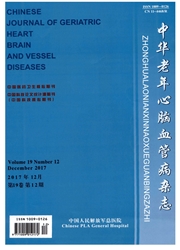

 中文摘要:
中文摘要:
目的 探讨老年基底节区脑出血早期神经功能恶化(END)与预后的关系.方法 连续选择头颅CT确诊为基底节区脑出血的患者99例,根据是否发生END分为END组37例和非END组62例,90例患者完成90d随访,并根据预后情况分为预后良好组46例和预后不良组44例,分析相关影响因素.结果 与非END组比较,END组入院加拿大卒中量表(CSS)评分[(5.6±1.9)分vs (7.1±1.9)分]、白细胞计数[(10.9±3.1)×10^9/Lvs (8.2±2.6)×10^9/L]、血肿体积[(17.6±20.2)ml vs (11.3±10.6)ml]及出血破入脑室比例(73.0% vs 25.8%)等明显变化,差异有统计学意义(P<0.05,P<0.01).与预后良好组比较,预后不良组入院CSS评分、白细胞计数、END、随机血糖、血肿体积及出血破入脑室比例有明显变化,差异有统计学意义(P<0.01).logistic回归分析显示,END是老年基底节区脑出血早期预后不良的独立危险因素(OR=5.602,95%CI:1.144-27.426,P=0.033).结论 老年基底节区脑出血发生END的患者早期预后较差.
 英文摘要:
英文摘要:
Objective To study the association of early neurological deterioration (END) and outcomes in elederly patients with cerebral hemorrhage in basal ganglia.Methods Ninety nine patients with cerebral hemorrhage in basal ganglia were divided into END group (n=37) and nonEND group (n=62).Ninety out of the 99 patients,who were followed up for 90 days,were then divided into good outcome group (n=46) and poor outcome group (n=44).Their outcomes-related factors were analyzed.Results The CSS score was significantly higher while the WBC count,hematoma volume and incidence of intraventricular hemorrhage were significantly lower in END group than in non-END group (5.6±1.9 vs 7.1±1.9,8.2±2.6 ×10^9/L vs 10.9±3.1×10^9/L,11.3±10.6 ml vs 17.6±20.2 ml,25.8% vs 73.0%,P〈0.05,P〈0.01).The CSS score,WBC count,serum blood glusoe level,hematoma volume and incidence of intraventricular hemorrhage were significantly lower in poor outcome group than in good outcome group(P〈0.01).Logistic regression analysis showed that END was an independent rtisk factor for the poor outcomes in patients with cerebral hemohrrage in basal ganglia (OR =5.602,95% CI:1.144-27.426,P =0.033).Conclusion The early outcomes are poor in patients with END in basal ganglia hemorrhage.
 同期刊论文项目
同期刊论文项目
 同项目期刊论文
同项目期刊论文
 Intranasal delivery of nerve growth factor attenuates aquaporins-4-induced edema following traumatic
Intranasal delivery of nerve growth factor attenuates aquaporins-4-induced edema following traumatic Feasibility of delivering mesenchymal stem cells via catheter to the proximal end of lesion artery i
Feasibility of delivering mesenchymal stem cells via catheter to the proximal end of lesion artery i 期刊信息
期刊信息
